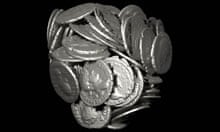Scientists have used a new x-ray technique to produce spectacular 3D images of Roman coins that were corroded inside pots or blocks of soil.
The rotating images built up from thousands of two-dimensional scans are so clear that individual coins can be identified and dated, without a single battered denarius – the Roman currency – being visible to the naked eye. The advantage of the new method – developed by a unique collaboration between archaeologists and scientists at the British Museum and Southampton University – is that it means coins can be identified and even dated much more quickly and without risking damage to them.

Roger Bland, a coins expert who is also head of the Portable Antiquities and Treasure schemes for reporting archaeological finds, based at the British Museum, said: "The initial results are very encouraging and in some cases remarkable. The techniques could have profound implications for the way we assess and study finds in the future, producing results in a few hours that would take a conservator weeks or even months."
Bland astonished the team at Southampton by sitting down with a sheaf of printouts and then identifying and dating each individual coin, including silver denarii from the reigns of Marcus Aurelius, Vespasian, Trajan and Hadrian, which were all still clumped together in a pottery cup, one of two found by an amateur with a metal detector in a field near Selby, Yorkshire.
The coins have since been painstakingly extracted from the pot and cleaned to confirm that the identification was spot on, and have gone on display in the British Museum's new Money gallery.

The hoard is still going through the Treasure process, and the British Museum hopes to acquire it. Uniquely, according to Eleanor Ghey, the archaeologist studying the find, chaff was found mixed with the coins, suggesting a ritual offering of food and money.
The technique could dramatically speed up assessing the significance of archaeological discoveries. With treasure finds – such as the huge Frome hoard of coins, or the dazzling Staffordshire hoard of Anglo-Saxon gold – under the present system finders and landowners, and museums which might want to raise funds to acquire them, all have to wait months or years.
Unlike conventional excavation, the technique avoids the risk of damage to corroding metal. As the method evolves it should be possible to fully study some objects without ever exposing them to daylight.
The x-ray technology at Southampton was originally developed to scan Rolls Royce turbine blades for flaws. Professor Ian Sinclair, director of the μ-VIS Centre for Computed Tomography, who is currently running an elephant's skull through the system to test its capabilities, said it was the largest of its kind and unique in Britain.
Dr Graeme Earl, an archaeologist member of the university's Archaeological Computing Research Group, said they were still learning the potential of the combined power of the x-ray machine, the knowledge of the academics and the skills of those producing the computer-generated images. "This gives archaeologists and conservators around the world the opportunity to virtually examine, excavate, and 'clean' objects."
He added: "We're still finding out what it can do – but anything up to roughly the size and shape of a rubbish bin, we'll have a crack at."




Comments (…)
Sign in or create your Guardian account to join the discussion